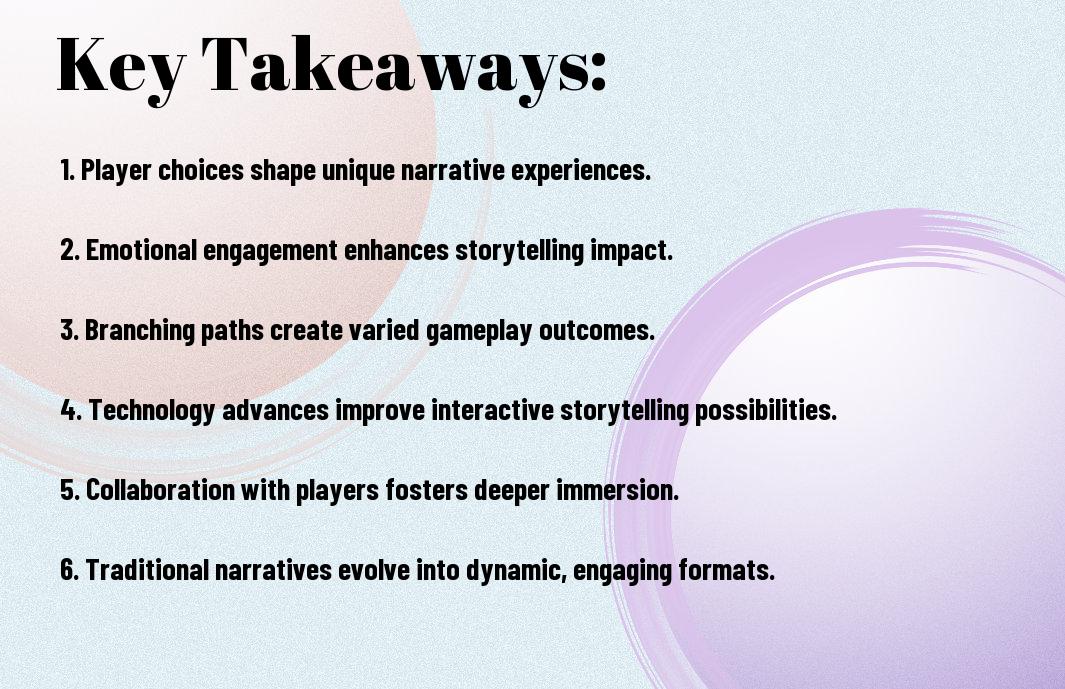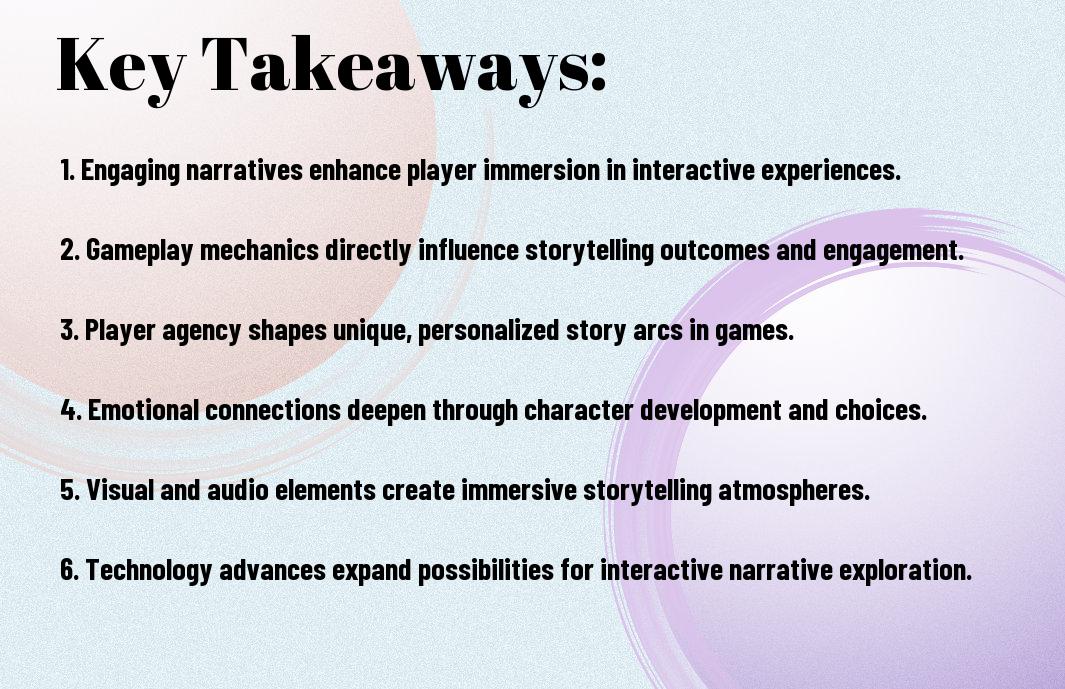As you examine into the world of gaming, you’re likely to notice a significant shift in the way stories are being told. You’re no longer just a passive observer, but an active participant in shaping the narrative. Your choices and actions have a direct impact on the story, making the experience more immersive and engaging. With interactive storytelling, you can expect a more dynamic and personalized experience, drawing you deeper into the game’s world and characters, and changing the way you interact with your favorite games forever.
Key Takeaways:
- Interactive storytelling is revolutionizing the gaming industry by allowing players to influence the narrative, creating a more immersive and engaging experience. This shift towards dynamic storytelling enables developers to craft unique stories that adapt to individual players’ choices and actions.
- The future of game narratives will likely involve advanced technologies such as artificial intelligence, virtual reality, and machine learning, which will further enhance the interactive storytelling experience. These technologies will enable developers to create more realistic and responsive game worlds that simulate real-life consequences and emotions.
- As interactive storytelling continues to evolve, it will become increasingly important for game developers to balance player agency with narrative coherence, ensuring that the story remains engaging and meaningful while still allowing players to make significant choices and contributions to the narrative.

The Evolution of Game Narratives
The development of game narratives has come a long way, and you can explore more about it in The Future of Storytelling: Virtual Reality, Interactive Narratives and Beyond, which sheds light on the advancements in this field.
From Linear to Branching Stories
Stories have transformed from linear to branching narratives, allowing you to experience a more dynamic and immersive gameplay, as your choices influence the storyline, creating a unique experience each time you play.
Player Agency and Choice Impact
On the other hand, the impact of your decisions on the game’s narrative is becoming more pronounced, enabling you to shape the story and its outcome, making your gameplay experience even more engaging and personalized.
For instance, when you make a choice in a game, it can lead to multiple outcomes, and you get to see the consequences of your actions, which can be a powerful tool for storytelling, as it makes you invested in the narrative and its characters, and you start to think about the potential consequences of your decisions, adding a layer of depth to your gameplay experience.
Core Elements of Interactive Storytelling
Any interactive storytelling experience relies on several key components that work together to create an immersive narrative. You will notice that these elements are crucial to drawing you into the story and keeping you engaged.
Dynamic Character Development
Character growth and evolution are vital aspects of interactive storytelling, as you witness your characters change and adapt in response to your decisions and actions, making the story feel more personal and dynamic.
Responsive World Building
Any world you interact with should be richly detailed and responsive to your actions, allowing you to feel like your decisions have a tangible impact on the environment and narrative, making your experience feel unique and tailored to your choices.
Hence, as you explore the world, you will start to uncover its secrets and shape its destiny, with the world’s responsiveness creating a sense of agency and investment in the story, making you feel like your actions have real consequences, and encouraging you to continue exploring and interacting with the world around you.
Narrative Design Technologies
Now, as you explore the world of interactive storytelling, you’ll discover the significance of narrative design technologies in shaping your gaming experience. These technologies enable developers to craft immersive stories that adapt to your actions, creating a unique journey each time you play.
AI-Driven Story Engines
Technologically advanced tools are being used to create AI-driven story engines that can generate narratives based on your decisions, allowing for a high level of replayability and depth in your gaming experience.
Procedural Content Generation
Behind the scenes, procedural content generation enables developers to create vast, detailed worlds that are tailored to your preferences, ensuring that your experience is always fresh and engaging.
Hence, as you examine deeper into procedural content generation, you’ll find that it allows developers to create games with virtually endless content, where the story and environment are generated on the fly, based on your actions and decisions, providing you with a unique experience each time you play.
Player Psychology in Interactive Stories
After delving into the world of interactive storytelling, you’ll find that understanding player psychology is key to creating an immersive experience. You’ll need to consider how your players think, feel, and behave in order to craft a narrative that resonates with them.
Emotional Investment
Prior to creating an engaging story, you must consider what motivates your players emotionally. You need to understand what drives their investment in the narrative and how to keep them engaged throughout the story.
Decision-Making Patterns
Akin to making choices in real life, your decision-making patterns in interactive stories can significantly impact the outcome. You make choices based on your preferences, values, and goals, which in turn, influence the story’s progression.
Interactive stories allow you to analyze your decision-making patterns, helping you understand what drives your choices. As you navigate through the narrative, you’ll encounter various dilemmas that test your moral compass, forcing you to weigh the pros and cons of each option, and ultimately, shaping the story’s outcome based on your decisions.
Writing Techniques for Games
Keep in mind that writing for games requires a unique approach, as you need to balance storytelling with player interaction and agency, allowing your narrative to unfold in a way that’s both engaging and immersive for your audience.
Multipath Narrative Structure
Following the development of your game’s story, you’ll want to consider a multipath narrative structure, which enables you to create a dynamic experience, with your players’ choices influencing the direction of the narrative, and you can use this technique to add depth and replayability to your game.
Environmental Storytelling
Around every corner, your game’s environment can be used to tell a story, with subtle details and clues that hint at the game’s lore and backstory, and you can use this technique to create a rich and immersive world that draws your players in and refuses to let go.
Consequently, as you explore deeper into environmental storytelling, you’ll find that it’s not just about creating a visually stunning world, but also about using your environment to convey themes, emotions, and ideas, and you can achieve this by paying attention to the small details, such as the architecture, lighting, and sound design, which all contribute to a cohesive and engaging narrative experience that enhances your game and leaves a lasting impression on your players.
The Role of Player Choice
For a more immersive experience, you need to consider the impact of player choice on your game’s narrative. As you design your story, think about how your players’ decisions will shape the plot and its outcome.
Meaningful Consequences
Besides the obvious effects, you should also consider the subtle implications of your players’ choices. As you weigh the pros and cons, you’ll create a more realistic and engaging experience for your players.
Narrative Loops and Branches
Beside the main storyline, you can create secondary paths that add depth to your narrative. By doing so, you’ll give your players a sense of agency and control over the story, making it more enjoyable and interactive.
Further exploration of narrative loops and branches allows you to create a complex web of storylines that cater to your players’ individual choices. As you design these loops and branches, you’ll be able to craft a unique experience for each player, making your game more replayable and engaging, and allowing you to see your story unfold in different ways based on the decisions you make.
To wrap up
Following this exploration of interactive storytelling, you now understand its potential to revolutionize game narratives. As you investigate into this world, you’ll discover how your choices shape the story, making each experience unique. Your engagement with interactive storytelling will redefine your expectations from games, and you’ll find yourself immersed in more personal and dynamic narratives, shaping the future of gaming with your every decision.
FAQ
Q: What is Interactive Storytelling and how does it impact the future of game narratives?
A: Interactive Storytelling refers to the integration of player choice and agency into the narrative of a game, allowing players to influence the story and its outcome. This approach has the potential to revolutionize the way game narratives are designed and experienced, providing a more immersive and engaging experience for players. By giving players the ability to shape the story, Interactive Storytelling enables a deeper level of emotional investment and connection to the game world and its characters.
Q: How does Interactive Storytelling enhance player engagement and immersion in games?
A: Interactive Storytelling enhances player engagement and immersion by providing a sense of agency and ownership over the narrative. When players are able to make choices that impact the story, they become more invested in the outcome and are more likely to be emotionally resonant with the game’s characters and world. This can lead to a more captivating and memorable gaming experience, as players are able to explore different story paths and outcomes, and experience a sense of discovery and surprise.
Q: What are the key challenges in implementing Interactive Storytelling in game development?
A: One of the key challenges in implementing Interactive Storytelling is the complexity of creating a narrative that can adapt to player choice and agency. This requires significant planning, design, and testing to ensure that the story remains coherent and engaging, regardless of the player’s decisions. Additionally, the use of branching narratives and multiple story paths can increase the scope and scale of the game’s development, requiring more resources and time to produce. However, the potential benefits of Interactive Storytelling make it a worthwhile investment for game developers.
Q: How does Interactive Storytelling impact the role of the game developer and writer in the game development process?
A: Interactive Storytelling requires game developers and writers to work closely together to create a cohesive and engaging narrative that is responsive to player choice and agency. This collaboration enables the creation of a more dynamic and immersive story, but also demands a high degree of flexibility and adaptability from the development team. Writers must be able to craft a narrative that can evolve and change in response to player input, while developers must be able to implement the technical systems that support this type of storytelling.
Q: What does the future hold for Interactive Storytelling in the game industry, and how will it continue to evolve and improve?
A: The future of Interactive Storytelling in the game industry is exciting and full of possibilities. As technology continues to advance, we can expect to see even more sophisticated and immersive forms of Interactive Storytelling, such as the use of artificial intelligence and machine learning to create dynamic, responsive narratives. Additionally, the growth of virtual and augmented reality technologies will provide new opportunities for Interactive Storytelling, enabling players to engage with game worlds and characters in entirely new and innovative ways. As the medium continues to evolve, we can expect to see Interactive Storytelling become an increasingly important part of the game development process, enabling the creation of more engaging, immersive, and memorable gaming experiences.






